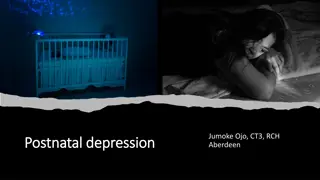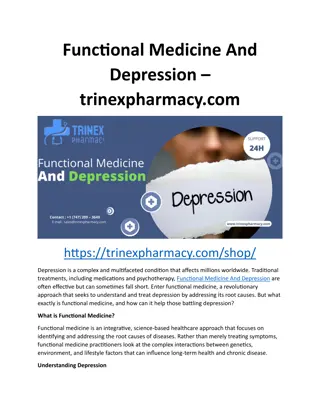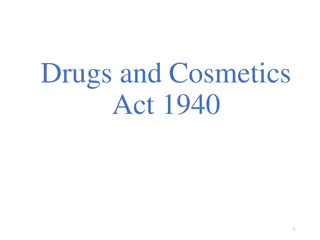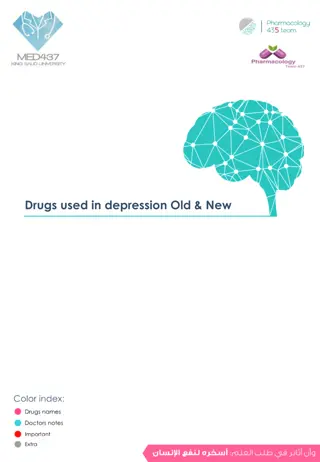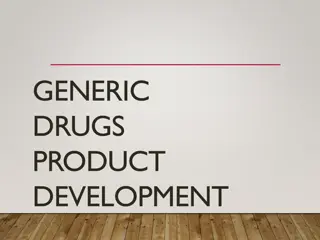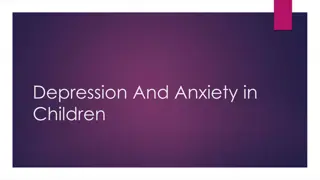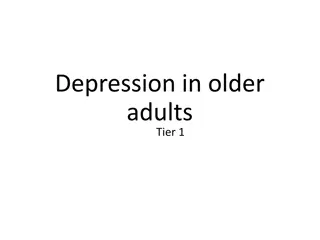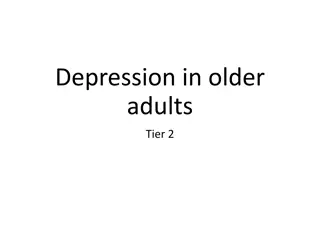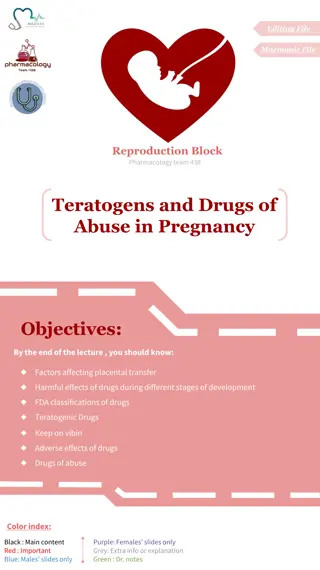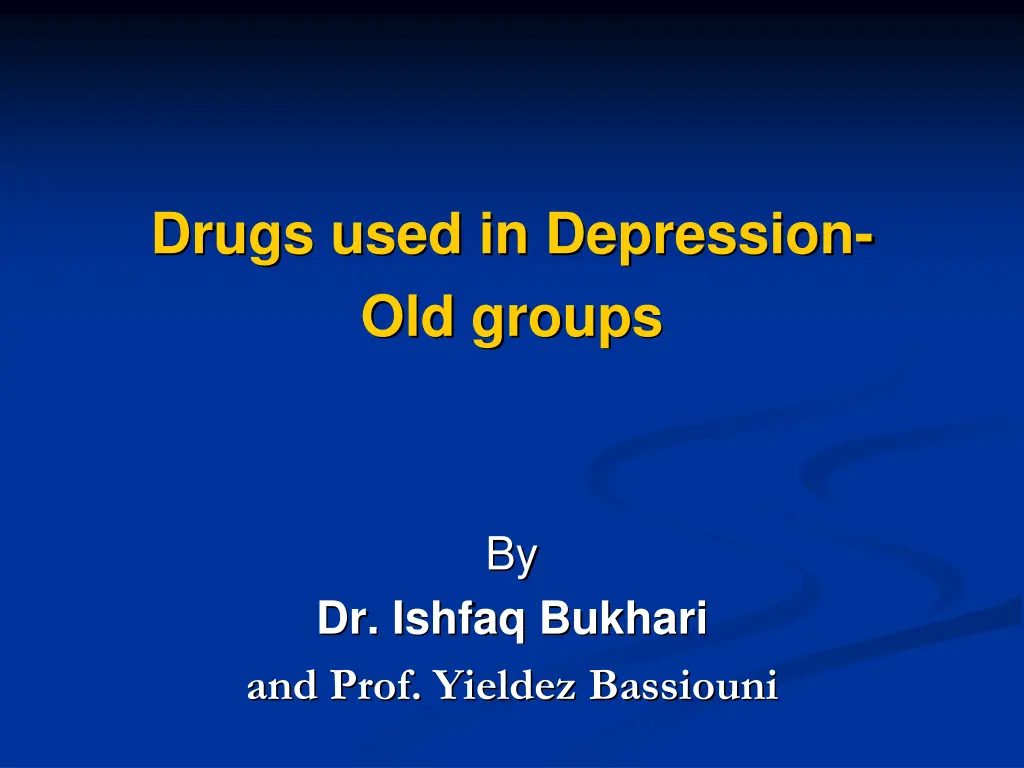
Understanding Drugs Used in Depression and Affective Disorders
Learn about the classification and symptoms of depression, including the biochemical theory of affective disorders and how drugs play a role in managing these conditions. Explore the incidence and cost of depression, as well as the different types of depression based on severity and mood swings. Discover the symptoms of depression and mania, gaining a deeper understanding of these common psychiatric disorders.
Download Presentation

Please find below an Image/Link to download the presentation.
The content on the website is provided AS IS for your information and personal use only. It may not be sold, licensed, or shared on other websites without obtaining consent from the author. If you encounter any issues during the download, it is possible that the publisher has removed the file from their server.
You are allowed to download the files provided on this website for personal or commercial use, subject to the condition that they are used lawfully. All files are the property of their respective owners.
The content on the website is provided AS IS for your information and personal use only. It may not be sold, licensed, or shared on other websites without obtaining consent from the author.
E N D
Presentation Transcript
Drugs used in Depression- Old groups By Dr. Ishfaq Bukhari and Prof. Yieldez Bassiouni
Depression "Depression" is a very common psychiatric disorder that is related (affective disorder). to the "mood" Changes in mood are associated with depression and/or mania. Disorders of mood rather than disturbance in thought or cognition.
Incidence: Depression is a chronic and recurrent illness that can affect at least 20% of the population at some period in their lifetime. Cost: 15-35 billions $ / year in USA only.
Classification of Depression A) According to severity of symptoms: 1. Mild depression---------self-limiting 2. Moderate depression -------difficulties at home and work 3. Severe depression --------serious, associated with suicidal thoughts
B) According to type 1- Unipolar depression (major depression): mood swings are always in the same direction (depresion) 2- Bipolar depression (manic-depressive): in which depression alternates with mania It is mainly hereditary and appears in early adult life
Symptoms of Depression Loss of energy and interest Diminished ability to enjoy oneself. Decreased -- or increased -- sleeping or appetite. Difficulty in concentrating; indecisiveness; slowed or fuzzy thinking. Exaggerated feelings of sadness, hopelessness, or anxiety. Feelings of worthlessness. Recurring thoughts about death and suicide. If most of these symptoms last for two weeks or more, the person probably has Depressive illness.
Symptoms of Mania causes mood swings creating periods with the following symptoms: A high energy level with decreased need for sleep. Unwarranted or exaggerated belief in one's own ability. Extreme irritability. Rapid, unpredictable emotional changes.
Biochemical Theory of Affective Disorders. Affective Disorders Serotonin NE NE Mania Depression Rx Drugs that decrease NE Drugs that increase NE What is the evidence to support this theory ? Amphetamine causes mania while reserpine and methyldopa produce depression (these drugs depletes NE and dopamine storage).
5-HT deficiency may cause the sleep problems, irritability and anxiety associated with depression Decreased level of NE, disturbance in mood. alertness, arousal, appetite, reward. However, dopamine is important for pleasure, Sexual function & psychomotor activity. What are the features of drugs that should be used for Rx of Depression? Simply to increase the levels of these amines.
Sites of Action for Antidepressants 1- Monoamine (NE or/ and 5-HT) re-uptake pump inhibitors 2- Blockade of pre-synaptic 2receptors 3- Inhibition of MAO enzyme
Classification of antidepressants based on site of action A ) Drugs that block the reuptake of NE and 5- HT ( e.g.:Most tricyclics) (old antidepressants) B) Drugs that Inhibit MonoAminoOxidase (MAOIs, Phenelzine, Tranylcypraine, Moclobemide) (old Antidepressants C) Drugs that selectively block reuptake of 5- HT (SSRIs) (Fluoxetine; Paroxetine; Citalopram) Sertraline; C) Drugs that Block Presynaptic 2- adrenoceptors (e.g.: Mirtazapine, Mianserin).
Antidepressants Available in the Market (Worldwide) 1) Tricyclics (TCAs) and Tetracyclics Imipramine Amoxapine Amitriptyline Nortriptyline 2) Monoamine Oxidase Inhibitors (MAOIs) Tranylcypramine Phenelzine Desipramine Clomipramine Maprotiline Moclobemide 3) Selective Serotonin Reuptake Inhibitors (SSRIs) Fluoxetine Sertraline Fluvoxamine Paroxetine Citalopram Escitralopram
Classification of Antidepressants 4) Serotonin and Norepinephrine Reuptake Inhibitor (SNRI) Venlafaxine Duloxetine 5) Serotonin-2 Antagonist and Reuptake Inhibitors (SARIs) Nefazodone Trazodone 6) Norepinephrine and Dopamine Reuptake Inhibitor (NDRI) Bupropion 7) Noradrenergic and Specific Serotonergic Antidepressant (NaSSAs) Mirtazapine 8) Noradrenaline Reuptake Inhibitor (NRI) Reboxetine
Slow onset of action Antidepressants do not act immediately (show clinical effects after 3 weeks) indicating that secondary adaptive changes must occur before the benefit is gained The most consistent adaptive change seen with antidepressant drugs is the downregulation of beta-, alpa-2 and 5-HT2 receptors. These receptor mediate negative feedback on monoamine release in the brain. Desensitization (down-regulation) of - adrenoceptors (decrease c-AMP ) is very important and is related to clinical response.
TRICYCLIC ANTIDEPRESSANTS (TCAs) TCAs are the oldest class of antidepressant drugs They have characteristic three-ring nucleus Imipramine Clomipramine Amitriptyline Nortriptyline TETRACYCLIC ANTIDEPRESSANTS Maprotiline Amoxapine Desipramine
MECHANISM OF ACTION of TCAs: All tricyclics block reuptake pumps for both 5HT and NE in nerve terminals by competing for binding site of the transport protein So conc. of NE & serotonin in the synaptic cleft & at the receptor site Some have more potency for inhibition of 5HT uptake pump; clomipramine, imipramine, amitryptyline Others have more potency for inhibition of NE uptake pump: nortriptyline, desipramine
PHARMACOLOGICAL ACTIONS 1- Elevate mood 2- Improve mental alertness 3- Increase physical activity # The antidepressant effect may develop after several weeks of continued treatment ( 2 - 3 weeks) 4- In non-depressed patients They cause sedation, confusion & motor incoordination
PHARMACOKINETICS of TCAs Peak levels: 2-6 hours post ingestion TCAs are "lipophilic" in nature, therefore they are well absorbed from the GIT and readily cross the blood brain barrier to penetrate the CNS. Elimination: hepatic oxidation TCAs are metabolized in the liver by demethylation (Imipramine to Desipramine, Nortriptyline) and by hydroxylation into metabolites that retain the biological activity of the parent compounds. Amitriptyline to
Side Effects of TCAs TCAs block: - 1 adrenergic receptors - H1 histamines receptors - M1 cholinergic receptors - 5HT2 receptors
Adverse Effects of TCAs Anti-cholinergic: Dry mouth, blurred vision, constipation & urine retention, aggravation of glaucoma. Anti-histaminic: Sedation, confusion. Anti-adrenergic Postural hypotension, arrhythmias, conduction defects. Weight gain, sexual dysfunction & impotence Lower seizure threshold TCAs have narrow therapeutic index toxicity can develop; excitement, , convulsions,, coma, atropine like- effects, cardiac arrhythmias, sudden death TADs have a large volume of distribution therefore hemodialysis is not effective for Rx of TCA toxicity also they are bound to plasma protiens.
Therapeutic uses of TCAs Endogenous (Major) Depression -- moderate to severe. Panic attack /acute episode of anxiety. Imipramine is used for treatment of nocturnal enuresis in children and geriatric patients as it constricts internal urethral sphincter (anti-muscarinic effect). Generalized Anxiety Disorder (GAD). Obsessive Compulsive Disorder (OCD) Attention Deficit Hyperkinetic Disorder (ADHD). Chronic neuropathic pains or unexplained body pains.
Interaction of TCAs with other drugs TCA are strongly bound to plasma protein, therefore their effect can be potentiated by drugs that compete for their plasma protein binding site ( Aspirin and Phenylbutazone). TCAs are metabolized by liver microsomal enzymes, therefore their effect can be reduced by inducers (Barbiturates), or potentiated by inhibitors of liver enzymes (Oral contraceptives, Antipsychotics, and SSRIs). TCAs (inhibitors of monoamine reuptake) should not be given with MAOIs (inhibitors of monoamine degradation) serotonergic and hypertensive crisis". Additive to antipsychotics & anti- parkinsonisms cholinergic effects. anti-
Contraindications TCAs should not be used in patients with Glaucoma or with enlarged prostate because of their atropine- like action. TCAs (given alone) are contraindicated in manic- depressive illness, because they tend to "switch" the depressed patient to the "manic" phase, therefore, they should be combined with "lithium salts". Seizure disorders (TCAs increases NA level in brain)
Monoamine Oxidase Inhibitors Clinical Uses: Only used for refractory cases and in atypical depression where phobia and anxiety are prominent symptoms. Limited use now because; ADR, Food & Drug Interactions Low antidepressant efficacy = Low benefit/risk ratio
Monoamine Oxidase MAO is a mitochondrial enzyme found in nearly all tissues Two forms of monoamine oxidase exist: MAO-Aresponsible for NE, 5-HT catabolism. It also metabolizes tyramine of ingested food MAO-B is more selective for dopamine metabolism Monoamine Oxidase Inhibitors (MAOIs)
Monoamine Oxidase Inhibitors (MAOIs) 1- Non Selective Inhibitors (MAO-A & MAO-B) Irreversible Phenelzine, long acting Reversible Tranylcypromine 2- Selective Reversible Inhibitors Moclobemide, (MAO-A) (antidepressant action, Short acting) Selegiline, (MAO-B) (used in the treatment of Parkinsonism) The effect of irreversible MAOIs persists for a period of 2-3 weeks after stopping treatment, time needed by the body to synthesize new enzyme.
Side Effects of MAOIs 1-Antimuscarinic effects. 2- Postural hypotension. 3- Sexual dysfunction mainly with phenelzine. 4- Sedation, sleep disturbance. 5- Weight gain. 6- Hepatotoxicity ( phenelzine).
MAOIs interaction with tyramine cheese reaction This occurs when Tyramine rich foods are taken with MAOIs. Tyramine rich foods Concentrated yeast products, Pickled or smoked fish, Red beans, Red Sausages. Tyramine in food is normally degraded in the gut by MAO-A. include Old cheese , Wine, Chicken liver, mouse
Since the enzyme is inhibited by MAOIs, tyramine from ingested food is absorbed, and then taken up into adrenergic neurons where it is converted into octopamine - a false transmitter which causes massive release of NE and may result in hypertensive crisis ; severe hypertension, severe headache and fatal intracranial haemorrhage. The special advantage claimed for Moclobemide is that, No cheese reaction occurs with its use.
Drug interactions of MAOIS 1- Pethidine: MAOIs interact with the opioid receptor agonist (pethidine) which may cause severe hyperpyrexia, restlessness, coma, hypotension. The mechanism still unclear but it is likely that an abnormal pethidine metabolite is produced because of inhibition of normal demethylation pathway. 2- Levodopa: Precursor of dopamine can interact with MAOIs leading to mania and hypertensive crisis.
Drug interactions of MAOIs 3- Amphetamine and Ephedrine: Indirectly acting sympathomimetics can interact with MAOIs causing the liberation of accumulated monoamines in neuronal terminals leading to hypertensive crisis. 4-TCAs (inhibitors of monoamine reuptake) can interact with MAOIs (inhibitors of monoamine degradation) leading to hypertensive crisis. 5- MAOIs & SSRIs ------- Serotonin syndrome (give 1-2weeks gap before initaiating SSRIs).


